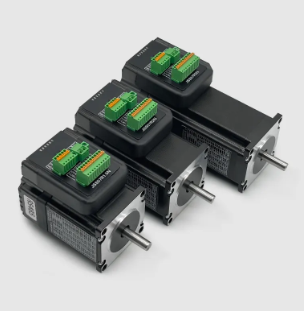Core Components of a Servo Motor
Motor Assembly: The Power Source
At the core of any servo motor sits the motor assembly, which turns electricity into actual movement. This part really makes the whole thing work when it comes to getting those accurate motions right. There are several motor options out there like AC and DC models, each better suited for different jobs. Most people go for AC motors when they need steady speed throughout operation, whereas DC versions tend to be preferred where speed and torque need adjusting on the fly. When picking a motor, efficiency numbers and how much power it puts out matter a lot because these things affect both how well the system performs and how much energy it eats up over time. Looking at some real world data shows that fine tuning these aspects not only makes systems last longer but also boosts their dependability, something plant managers care deeply about in manufacturing settings.
Feedback Device: Precision Control Element
Feedback devices are key to keeping servo motors precise because they give real time info about where the motor is, how fast it's spinning, and what kind of force it's applying. These gadgets basically connect what the control system wants to happen with what actually happens in the motor itself. Most factories use either encoders or resolvers for this job. Encoders are great when something needs to move really precisely, like in semiconductor manufacturing equipment. They provide super detailed position information. Resolvers work better in tough conditions though, which is why they're often seen in heavy industrial settings where dust and vibration are problems. Looking at actual factory data, companies that invest in good feedback systems see noticeable improvements in both how accurately their motors perform and overall energy efficiency. This has led to wider adoption across robotics and automated production lines in recent years.
Controller Circuitry: Brain of the Operation
The controller circuitry serves as the central component of a servo motor system, taking in signals and determining how the motor should move. This part handles sophisticated control methods such as PID control (which stands for Proportional, Integral, Derivative) to keep things running smoothly at the required level. When the controller modifies its operation according to what it sees happening right now through feedback mechanisms, it keeps the motor following exactly where it needs to go without straying off course. We've seen real improvements in how quickly these motors respond thanks to better algorithm development, something that's made a big difference in robot design projects recently. The boost in both efficiency and accuracy matters a lot in different industries too. Think about car factories needing precise assembly or aircraft systems requiring exact positioning during flight operations.
Understanding the Motor Assembly
Stator and Rotor Configuration
In a servo motor, how the stator and rotor are set up matters a lot for how it works because these parts team up to turn electricity into actual movement. The stator sits still inside the motor and has those wire windings around it. When we apply power to it, it makes a magnetic field. Meanwhile, the rotor has magnets attached and spins around inside that magnetic field created by the stator. That back and forth between them is what gets things moving. How we arrange those windings really affects how well the motor performs overall. Some setups give better results than others. Take concentrated windings for instance they pack a punch when it comes to torque but may not be as efficient. On the flip side, distributed windings tend to run smoother and waste less energy, even if they don't deliver quite the same raw power.
Brushless vs Brushed Motor Types
There are basically two types of servo motors out there: brushed and brushless. The brushed ones have that simple design and tend to be cheaper because they rely on those little carbon brushes to send power to the spinning part inside. That's why we see them mostly in cheap toys or entry level robots where budget matters most. But here's the catch: those brushes get worn down over time and require replacing pretty regularly. Brushless motors tell a different story altogether though. Without all those wearing parts, they run cleaner, last longer, and just plain work better in general. These bad boys show up everywhere from high end drones buzzing around warehouses to precision CNC machines cutting metal in factories. Take a look at lifespan numbers too. Most brushed motors will give maybe 3,000 hours before needing attention, whereas brushless models can easily hit 10,000 hours or more without breaking a sweat. No wonder industries keep switching to these tougher options when reliability counts.
Feedback Systems in Servo Motors
Encoder Types and Resolution
Knowing about different encoder types and their resolution levels matters a lot when it comes to getting accurate results from servo motors. Most commonly, there are two main options available: incremental encoders and absolute encoders. The incremental ones basically track how much something has moved from a starting point by counting pulse signals. Absolute encoders work differently though they give exact position information right away without needing any reference point first. What we call encoder resolution refers to how many separate positions the device can actually detect, which makes all the difference in where things end up in practical applications. When systems use higher resolution encoders, they get better data that leads to smoother motion control and greater accuracy overall. Take robotic arms on production floors as an example. With top notch encoders installed, these machines can place components with pinpoint accuracy during manufacturing processes, ultimately resulting in better quality products and saving time across operations.
Resolver Functionality
In servo motor systems, resolvers are essential for getting accurate feedback, particularly when reliability matters most. These devices consist basically of a rotor and stator with windings, working kind of like a rotating transformer to give continuous position information. What really stands out about resolvers is how tough they are. They can handle all sorts of rough conditions including extreme heat, constant vibration, and even dirt and grime that would disable other sensors. For this reason, many aerospace and defense manufacturers rely heavily on them. Take aircraft control systems for instance, where these components keep performing despite all the stress factors during flight operations. The aviation sector alone has countless examples showing why resolvers remain go-to solutions for critical applications where failure simply isn't an option.
Control Circuitry Breakdown
PWM Signal Processing
PWM plays a key role in controlling servo motors because it affects how fast they spin and where they position themselves. At its core, PWM basically changes how long the electrical signal stays on versus off during each cycle that runs through the motor. When these pulses get adjusted properly, they actually change important aspects of motor performance like speed and torque levels. The way power gets delivered makes all the difference for what the motor does. Motors running on high frequency PWM tend to move much smoother and respond more accurately than those using lower frequencies. Engineers who work with industrial automation systems know this well from experience. Good PWM setups not only make motors perform better but also save energy over time while making sure the motors last longer before needing replacement parts.
Error Amplification Stages
Error amplification is really important for how servo motors work because it helps keep things running smoothly and reacting fast when needed. Basically, these amplification stages take the feedback coming back from the motor and fix whatever isn't matching what should happen. If there's a drift in position or speed, the system catches it right away. Most engineers rely on stuff like PID controllers Proportional, Integral, Derivative to handle all these corrections. They've been around for ages but still get the job done pretty well. Studies show that better error correction techniques can boost response times by about 20% in many servo setups. That makes sense why manufacturers continue investing in this area since faster reactions mean more accurate operations across different industrial applications.
Drive Mechanism Essentials
Gear Reduction Systems
Reduction systems play a major role when it comes to servo motors, boosting torque output while giving better control over how fast the motor runs. When manufacturers install different kinds of gears including common ones like spur, helical, and planetary configurations, they enable the motor to handle bigger workloads without needing to bulk up the motor itself or consume extra power. The choice between these gear options matters quite a bit for performance outcomes. Spur gears tend to show up in basic setups because they're simple to manufacture and generally reliable enough for everyday operations. Planetary gears though deliver much greater torque packed into smaller spaces plus smoother running characteristics, which explains why engineers prefer them for tougher industrial jobs. We see these gear reductions all over manufacturing floors particularly in robotic arms working on production lines. Without proper gearing, those machines wouldn't be able to maintain the exact movements needed for quality assembly work day after day.
Output Shaft Specifications
When looking at what makes a servo motor work well with different equipment, the output shaft specs matter a lot. Shaft size and what it's made from really affect how reliable and performant the motor will be. Bigger shafts generally handle heavier loads better, which is why they show up in tough industrial settings. Materials count too stainless steel holds up pretty well against wear and tear, while titanium offers even greater strength when space matters most. Following standard guidelines like those set by ISO or ANSI helps manufacturers create shaft designs that last longer and run smoother over time. Getting these details right means the motor actually works as intended in real world conditions rather than just on paper. Proper specification matching becomes essential for any system where downtime costs money and precision matters.
FAQs
What are the main components of a servo motor?
The main components of a servo motor include the motor assembly, feedback device, controller circuitry, and drive mechanism essentials such as gear reduction systems and output shaft specifications.
Why are brushless motors preferred over brushed motors?
Brushless motors are preferred over brushed motors due to their higher efficiency, lower maintenance requirements, and longer lifespan, making them suitable for demanding applications.
How does a feedback device enhance servo motor performance?
A feedback device provides real-time data on the motor's position, speed, and torque, enabling precise performance and allowing the system to bridge the gap between command signals and motor response.
What is the role of PWM in servo motors?
PWM, or Pulse Width Modulation, is used to control speed and positioning by varying the duration of electrical signal cycles, impacting motor performance metrics such as speed and torque.
How does gear reduction system benefit servo motors?
Gear reduction systems increase torque and allow for precise control over motor speed, aiding in managing larger loads without increasing the motor's size or energy consumption.

